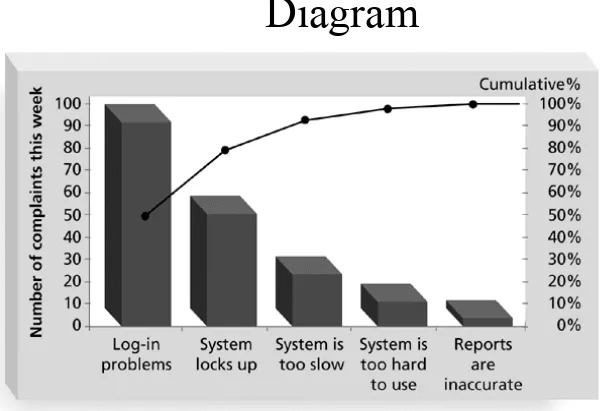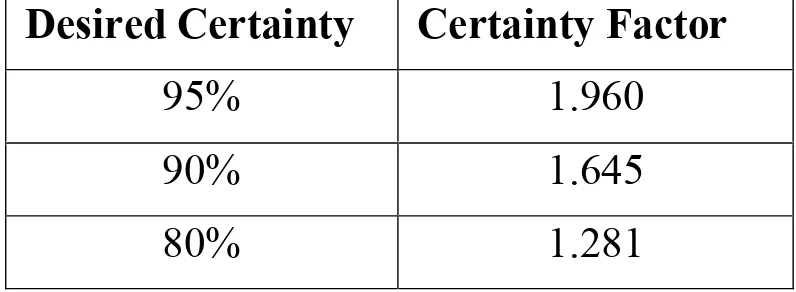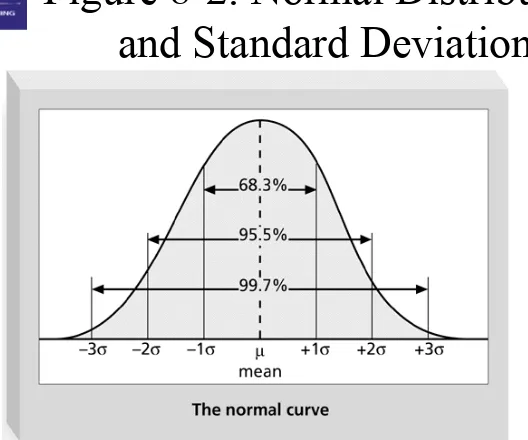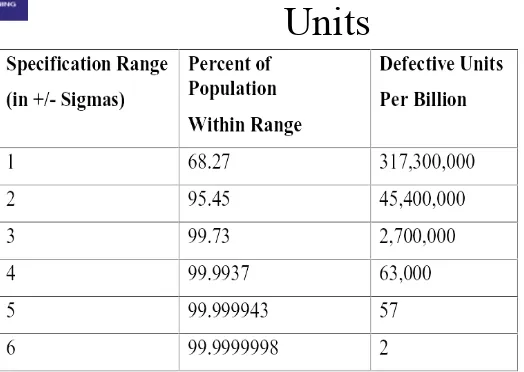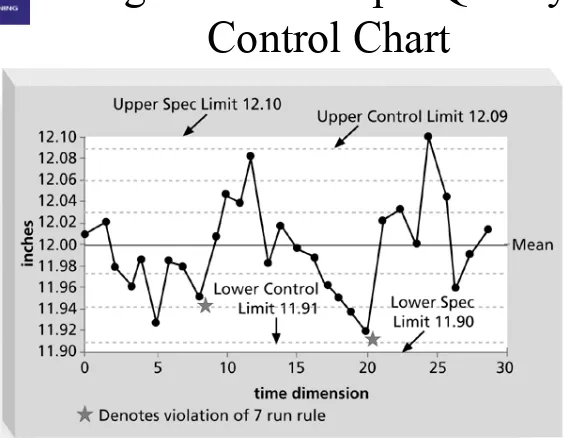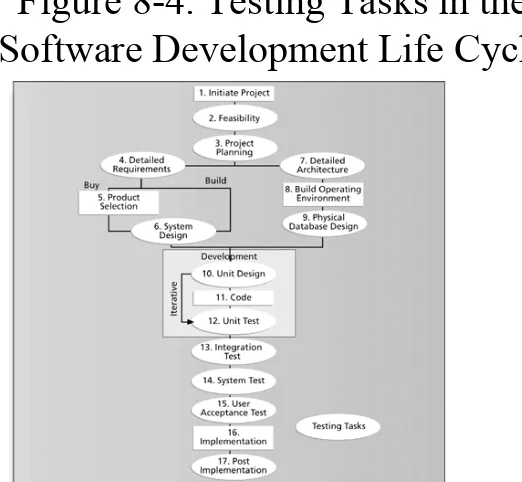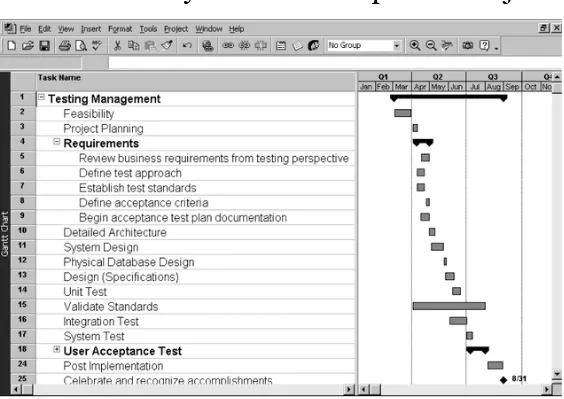Chapter 8:
2 IT Project Management, Third Edition Chapter 8
Learning Objectives
• Understand the importance of project quality management for information technology products and services
• Define project quality management and understand how quality relates to various aspects of information technology projects
• Describe quality planning and its relationship to project scope management
• Discuss the importance of quality assurance
• List the three outputs of the quality control process
Learning Objectives
• Describe important concepts related to Six Sigma and how it helps organizations improve quality and reduce costs
• Summarize the contributions of noteworthy quality experts to modern quality management
• Understand how the Malcolm Baldrige Award and ISO 9000 standard promote quality in project management
• Describe how leadership, cost, organizational influences, and maturity models relate to improving quality in
information technology projects
4 IT Project Management, Third Edition Chapter 8
Quality of Information
Technology Projects
• Many people joke about the poor quality of IT products (see cars and computers joke on p.
262)
• People seem to accept systems being down occasionally or needing to reboot their PCs • There are many examples in the news about
quality problems related to IT (See What Went Wrong?)
What Is Quality?
• The International Organization for
Standardization (ISO) defines quality as the totality of characteristics of an entity that bear on its ability to satisfy stated or implied needs • Other experts define quality based on
– conformance to requirements: meeting written specifications
6 IT Project Management, Third Edition Chapter 8
Project Quality Management
Processes
• Quality planning: identifying which quality
standards are relevant to the project and how to satisfy them
• Quality assurance: evaluating overall project
performance to ensure the project will satisfy the relevant quality standards
• Quality control: monitoring specific project results to ensure that they comply with the
Quality Planning
• It is important to design in quality and
communicate important factors that directly contribute to meeting the customer’s
requirements
• Design of experiments helps identify which
variables have the most influence on the overall outcome of a process
• Many scope aspects of IT projects affect quality like functionality, features, system outputs,
8 IT Project Management, Third Edition Chapter 8
Quality Assurance
• Quality assurance includes all the activities
related to satisfying the relevant quality standards for a project
• Another goal of quality assurance is continuous quality improvement
• Benchmarking can be used to generate ideas for quality improvements
10 IT Project Management, Third Edition Chapter 8
Quality Control
• The main outputs of quality control are
– acceptance decisions – rework
– process adjustments
• Some tools and techniques include
– Pareto analysis
– statistical sampling – Six Sigma
12 IT Project Management, Third Edition Chapter 8
Pareto Analysis
• Pareto analysis involves identifying the vital few contributors that account for the most quality problems in a system
• Also called the 80-20 rule, meaning that 80% of problems are often due to 20% of the causes
14 IT Project Management, Third Edition Chapter 8
Statistical Sampling and Standard
Deviation
• Statistical sampling involves choosing part of a population of interest for inspection
• The size of a sample depends on how
representative you want the sample to be • Sample size formula:
Table 8-2. Commonly Used
Certainty Factors
Desired Certainty Certainty Factor
95% 1.960
90% 1.645
80% 1.281
95% certainty: Sample size = 0.25 X (1.960/.05) 2 = 384
90% certainty: Sample size = 0.25 X (1.645/.10)2 = 68
16 IT Project Management, Third Edition Chapter 8
Six Sigma Defined
• Six Sigma is “a comprehensive and flexible system for achieving, sustaining and
maximizing business success. Six Sigma is uniquely driven by close understanding of
customer needs, disciplined use of facts, data, and statistical analysis, and diligent attention to managing, improving, and reinventing business processes.”*
Basic Information on Six Sigma
• The target for perfection is the achievement of no more than 3.4 defects per million
opportunities
• The principles can apply to a wide variety of processes
18 IT Project Management, Third Edition Chapter 8
DMAIC
• Define: Define the problem/opportunity, process, and customer requirements
• Measure: Define measures, collect, compile, and display data
• Analyze: Scrutinize process details to find improvement opportunities
• Improve: Generate solutions and ideas for improving the problem
• Control: Track and verify the stability of the
How is Six Sigma Quality Control
Unique?
• It requires an organization-wide commitment • Six Sigma organizations have the ability and willingness to adopt contrary objectives, like reducing errors and getting things done faster • It is an operating philosophy that is
customer-focused and strives to drive out waste, raise levels of quality, and improve financial
20 IT Project Management, Third Edition Chapter 8
Examples of Six Sigma
Organizations
• Motorola, Inc. pioneered the adoption of Six Sigma in the 1980s and saved about $14 billion • Allied Signal/Honeywell saved more than $600
million a year by reducing the costs of
reworking defects and improving aircraft engine design processes
Six Sigma and Project
Management
• Joseph M. Juran stated that “all improvement takes place project by project, and in no other way”
• It’s important to select projects carefully and apply higher quality where it makes sense
• Six Sigma projects must focus on a quality problem or gap between current and desired performance and not have a clearly understood problem or a predetermined solution • After selecting Six Sigma projects, the project
22 IT Project Management, Third Edition Chapter 8
Six Sigma and Statistics
• The term sigma means standard deviation • Standard deviation measures how much
variation exists in a distribution of data • Standard deviation is a key factor in
determining the acceptable number of defective units found in a population
• Six Sigma projects strive for no more than 3.4 defects per million opportunities, yet this
Standard Deviation
• A small standard deviation means that data cluster closely around the middle of a
distribution and there is little variability among the data
24 IT Project Management, Third Edition Chapter 8
26 IT Project Management, Third Edition Chapter 8
Table 8-4: Six Sigma Conversion
Table
The Six Sigma convention for determining defects is based on the
above conversion table. It accounts for a 1.5 sigma shift to account for time and measures defects per million opportunities, not defects
Quality Control Charts and the
Seven Run Rule
• A control chart is a graphic display of data that illustrates the results of a process over time. It helps prevent defects and allows you to
determine whether a process is in control or out of control
• The seven run rule states that if seven data points in a row are all below the mean, above, the
mean, or increasing or decreasing, then the
28 IT Project Management, Third Edition Chapter 8
Testing
• Many IT professionals think of testing as a stage that comes near the end of IT product
development
30 IT Project Management, Third Edition Chapter 8
Types of Tests
• A unit test is done to test each individual
component (often a program) to ensure it is as defect free as possible
• Integration testing occurs between unit and system testing to test functionally grouped components
• System testing tests the entire system as one entity • User acceptance testing is an independent test
32 IT Project Management, Third Edition Chapter 8
Modern Quality Management
• Modern quality management
– requires customer satisfaction – prefers prevention to inspection
– recognizes management responsibility for quality
• Noteworthy quality experts include Deming, Juran, Crosby, Ishikawa, Taguchi, and
34 IT Project Management, Third Edition Chapter 8
Quality Experts
• Deming was famous for his work in rebuilding Japan and his 14 points
• Juran wrote the Quality Control Handbook and 10 steps to quality improvement
• Crosby wrote Quality is Free and suggested that organizations strive for zero defects
• Ishikawa developed the concept of quality circles and pioneered the use of Fishbone diagrams
• Taguchi developed methods for optimizing the process of engineering experimentation
36 IT Project Management, Third Edition Chapter 8
Malcolm Baldrige Award and
ISO 9000
• The Malcolm Baldrige Quality Award was started in 1987 to recognize companies with world-class quality
• ISO 9000 provides minimum requirements for an organization to meet their quality
Improving Information
Technology Project Quality
• Several suggestions for improving quality for IT projects include
– Leadership that promotes quality – Understanding the cost of quality
– Focusing on organizational influences and workplace factors that affect quality
38 IT Project Management, Third Edition Chapter 8
Leadership
• “It is most important that top management be quality-minded. In the absence of sincere
manifestation of interest at the top, little will happen below.” (Juran, 1945)
The Cost of Quality
• The cost of quality is
– the cost of conformance or delivering products that meet requirements and fitness for use
40 IT Project Management, Third Edition Chapter 8
Table 8-5. Costs Per Hour of Downtime
Caused by Software Defects
Business Cost per Hour Downtime
Five Cost Categories Related to Quality
• Prevention cost: the cost of planning and executing a project so it is error-free or within an acceptable error range
• Appraisal cost: the cost of evaluating processes and their outputs to ensure quality
• Internal failure cost: cost incurred to correct an identified defect before the customer receives the product
• External failure cost: cost that relates to all errors not detected and corrected before delivery to the customer
• Measurement and test equipment costs: capital cost of
42 IT Project Management, Third Edition Chapter 8
Organization Influences,
Workplace Factors, and Quality
• A study by DeMarco and Lister showed that
organizational issues had a much greater influence on programmer productivity than the technical environment or programming languages
• Programmer productivity varied by a factor of one to ten across organizations, but only by 21% within the same organization
• The study found no correlation between productivity and programming language, years of experience, or salary
Maturity Models
• Maturity models are frameworks for helping
organization improve their processes and systems
– Software Quality Function Deployment model
focuses on defining user requirements and planning software projects
– The Software Engineering Institute’s Capability Maturity Model provides a generic path to process improvement for software development
– Several groups are working on project management maturity models, such as PMI’s Organizational
44 IT Project Management, Third Edition Chapter 8
Project Management Maturity Model
1. Ad-Hoc: The project management process is described as disorganized, and occasionally even chaotic. The organization has not defined systems and
processes, and project success depends on individual effort. There are chronic cost and schedule problems.
2. Abbreviated: There are some project management processes and systems in place to track cost, schedule, and scope. Project success is largely unpredictable and cost and schedule problems are common.
3. Organized: There are standardized, documented project management processes and systems that are integrated into the rest of the organization. Project success is more predictable, and cost and schedule performance is improved.
4. Managed: Management collects and uses detailed measures of the effectiveness of project management. Project success is more uniform, and cost and schedule
performance conforms to plan.
Using Software to Assist in
Project Quality Management
• Spreadsheet and charting software helps create Pareto diagrams, Fishbone diagrams, etc.
• Statistical software packages help perform statistical analysis
• Specialized software products help manage Six Sigma projects or create quality control charts
• Project management software helps create Gantt charts and other tools to help plan and track
